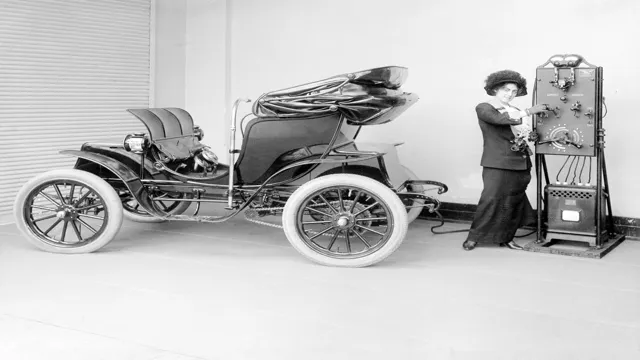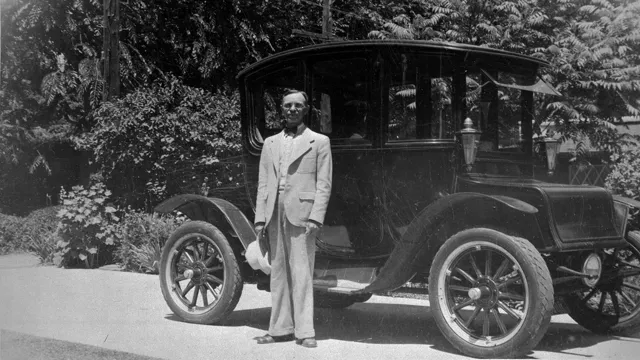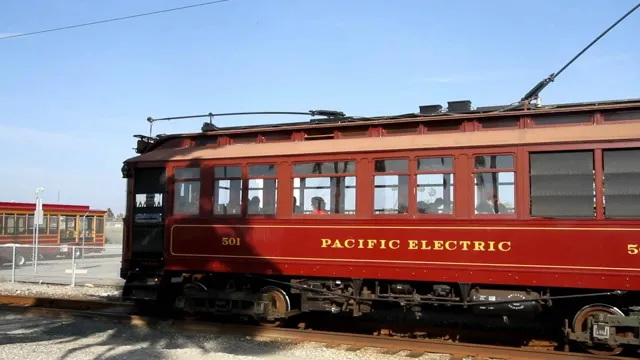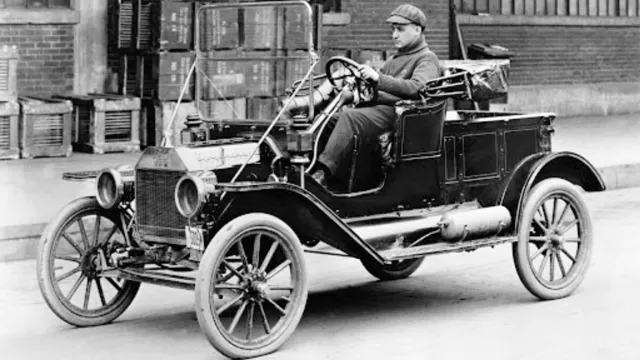Journey Through Time: Uncovering the Fascinating History of Electric Street Cars
Electric streetcars are not a new concept. In fact, did you know that electric streetcars were actually prevalent in many cities way back in the late 1800s? However, their success was short-lived as they were eventually replaced by other forms of transportation like buses and cars. Flash forward to today, and electric streetcars are now making a comeback.
Cities are once again seeing the value and benefits of electric streetcars and are investing in their revival. But what caused this sudden resurgence, and why are they becoming so popular once again? In this blog post, we will explore the rise of electric streetcars and their impact on modern transportation systems. Join us as we dive into the historical significance of electric streetcars, their modern-day revamp, and the benefits they bring to urban areas.
Early Developments
The history of electric street cars dates back to the late 1800s when the first prototype was introduced by Frank Sprague. His design utilized an overhead wire system to power the car, which quickly became popular in major cities across the globe. The electric street car revolutionized transportation, providing a faster, cleaner, and safer mode of travel compared to traditional horse-drawn carriages.
By the early 1900s, electric street cars had become a staple in cities like New York and San Francisco, with hundreds of miles of track crisscrossing their urban landscapes. However, the rise of the automobile industry in the early 1900s led to a decline in electric street cars, as well as a concerted effort by oil companies to discredit them. Despite their decline, electric street cars continue to be an essential part of many cities’ public transportation systems to this day, providing an eco-friendly alternative to cars and buses.
Invention of the Electric Trolley
Early developments in the invention of the electric trolley were based on the desire to find a more efficient alternative to horse-drawn streetcars. In 1880, Frank J. Sprague, an American inventor and electrical engineer, successfully tested a working model of an electric trolley system in Richmond, Virginia.
This innovation replaced the bulky, unreliable steam engine previously used to power streetcars and made transportation more reliable, accessible, and cost-effective. One of the advantages of the electric trolley was the ability to travel faster and climb steeper grades than the horse-drawn vehicles, making it a popular choice for city transportation. The development of this mode of transportation dramatically increased public access to jobs, shopping, and recreation, making it an essential component of urban infrastructure.
Today, the electric trolley remains a reliable and environmentally friendly method of public transportation, reflecting the significant early developments that spurred its invention.

Growth of Electric Street Cars in the 19th Century
The 19th century saw the rapid growth of electric street cars that revolutionized urban transportation. Early developments in the industry saw the birth of experimental battery-powered cars that were limited in speed and range. However, with the growth of new technologies, such as the dynamo and the alternating current motor, electric streetcars became faster, more reliable, and able to cover longer distances.
The first large-scale electric street railway system was installed in Richmond, Virginia, in 1888, followed by cities such as New York and Boston, which quickly adopted the new mode of transport. With the rise of electric street cars, cities became more accessible, and the transportation of goods became faster and more efficient. The growth of the electric streetcar industry also helped pave the way for the development of urban planning and modern city infrastructure.
Overall, early developments in electric streetcar technology paved the way for a transportation revolution that would forever change the way we live and move around our cities.
The Golden Age of Electric Street Cars
The golden age of electric street cars, which took place in the late 19th and early 20th centuries, was a time when electric-powered transportation was transforming the landscape of urban areas around the world. These street cars ran on rails, providing efficient and reliable transportation for city dwellers. The history of electric street cars is a fascinating one, as it tells the story of innovation, technological advancements, and the birth of modern-day transportation.
The development of these electric street cars was a significant step towards reducing congestion on the streets and making public transportation accessible to all. The use of electricity as a power source created a new era in transportation that allowed us to move faster and more efficiently than ever before. It’s amazing to think about how far we’ve come since those early days of electric street cars, and yet, there’s still so much more to be done to help us meet the challenges of modern transportation.
Expansion of Street Car Networks
During the late 19th and early 20th centuries, electric streetcars were the predominant mode of transportation in many cities across the United States. Dubbed the “Golden Age” of streetcars, this network was expansive and connected countless communities. It allowed people to quickly and comfortably travel to work, school, and other destinations in a way that had previously been impossible.
However, the rise of automobiles and suburbanization led to the decline of streetcars, and today, only a handful of cities still have operational streetcar networks. Yet, efforts are being made to revive this once-dominant transportation option, with many cities exploring the potential of modern streetcar systems that meet the needs of contemporary urban environments. These electric streetcars offer a sustainable mode of transportation that can reduce congestion and provide greater access to urban areas, and it’s exciting to see more cities embracing this idea and investing in the future of their public transportation networks.
Technological Advances in Electric Transportation
The Golden Age of Electric Street Cars marked a significant advancement in electric transportation technology. These electric street cars were powered by overhead cables and quickly gained popularity in the late 1800s and early 1900s due to their convenience and efficiency. Electric street cars helped alleviate traffic congestion in urban areas and were often a more affordable option for transportation, especially for working-class individuals.
They were also eco-friendly since they emitted little to no pollution. However, the rise of the automobile industry eventually led to the decline of electric street cars, as car manufacturers focused on promoting gasoline-powered cars. Despite their decline, electric street cars paved the way for the development of modern electric transportation and serve as a reminder of the potential of eco-friendly forms of transportation.
The Battle Between Public and Private Transit Companies
The history of public and private transit companies has been long and contentious, with the battle between the two reaching its peak during the golden age of electric street cars. At the time, public transit companies had established a strong foothold in urban areas, providing reliable and affordable transportation options to the masses. Private transit companies, however, saw an opportunity to capitalize on the growing demand for transit services and started to develop their own electric street car lines.
This sparked a fierce competition between the two, with each side vying for control of the market. While public transit companies held the advantage of established routes and infrastructure, private companies had the benefit of more modern and efficient vehicles. Ultimately, the battle between the two sides ended with the dismantling of the electric street car network and the rise of automobile-focused transportation.
However, the legacy of the golden age of street cars lives on, with many people advocating for the return of public transit as a way to combat urban congestion and promote sustainable transportation options.
Decline of Electric Street Cars
The history of electric street cars is a fascinating one, with a rise and fall that reflects the changing times and interests of society. At one point, electric street cars were the main mode of transportation in cities across America, providing an efficient and convenient way for people to get around. But with the advent of the automobile and the rise of car culture, interest in electric street cars began to decline.
Many cities began to dismantle their street car systems in favor of new roads and highways, and by the mid-20th century, electric street cars had all but disappeared from the urban landscape. Today, there is renewed interest in electric transportation, with electric cars and light rail systems gaining popularity. However, the decline of electric street cars remains a reminder of the power of technology and the fickle nature of public opinion.
Rise of the Automobile Industry
The rise of the automobile industry in the early 1900s resulted in the decline of electric streetcars. The convenience and freedom of personal vehicles led people to abandon public transportation. While electric streetcars had become popular in the late 1800s, the cost of maintaining their infrastructure and tracks made them less profitable than automobiles.
Additionally, the automobile industry had powerful lobbyists who pushed for the expansion of roads and highways, while legislation was introduced to limit or remove streetcars from cities. The car industry ultimately won out, and electric streetcars were slowly phased out. It’s interesting to think about how the transportation industry could have looked different today if electric streetcars had managed to maintain their popularity.
But for now, cars are king of the road.
Government Intervention and Regulations
In the early 20th century, electric street cars were a popular mode of transportation in many American cities. However, the rise of the automobile industry and political corruption led to the decline and eventual extinction of street cars. Government intervention and regulations played a key role in this process.
In particular, automobile manufacturers and oil companies lobbied for laws and policies that favored personal vehicles over public transportation. Additionally, many cities began to subsidize highways and roads, while neglecting their street car systems. As a result, street cars became less efficient and more costly, leading to their eventual demise.
Today, we can still see the effects of this decline in the lack of public transit options in many cities. It’s important to recognize the role that government intervention and regulation can play in shaping our transportation systems, and to advocate for policies that prioritize sustainable, affordable, and accessible forms of transportation.
Revival and Future of Electric Street Cars
The history of electric street cars dates back to the late 1800s, when they were first introduced in many major cities. These early modes of public transportation revolutionized urban mobility and allowed people to easily travel from one place to another. However, with the introduction of automobiles and buses, electric street cars gradually lost popularity and were phased out in the mid-1900s.
Thankfully, there has been a recent revival of electric street cars in many cities, as people have become increasingly concerned about reducing their carbon footprint and improving air quality. These modern electric street cars are more energy-efficient than their predecessors and use renewable sources of energy to function. They offer a clean and sustainable alternative to traditional modes of public transportation and have the potential to transform the way we travel in cities.
As urban populations continue to grow, it is important that we prioritize sustainable transportation options like electric street cars. By investing in these innovative modes of transportation, we can create cleaner and more livable cities for future generations.
Conclusion
The history of electric street cars is a shining example of human ingenuity and innovation. From the humble beginnings of horse-drawn trams to the sleek and eco-friendly modern electric streetcars, this industry has come a long way. It’s a story of progress, perseverance, and the power of technology to shape our world.
But perhaps the most interesting thing about electric street cars is how they mirror the ebb and flow of society. In their heyday, streetcars were a symbol of progress, modernity, and mobility for all. They represented the democratization of transportation and the end of isolation.
But as cars became more affordable and suburbs started to sprawl, streetcars were seen as outdated and inefficient. They were abandoned and left to rust away. Thankfully, today the electric streetcar is making a comeback.
As cities struggle to reduce traffic congestion and promote sustainability, streetcars are once again seen as a viable and eco-friendly alternative. It’s a second chance for a technology that was once written off as obsolete. So the history of electric streetcars is a story of innovation and, ultimately, resilience.
It’s a reminder that sometimes, the best ideas just need a little time to shine again.”
FAQs
When were electric street cars first introduced?
Electric street cars were first introduced in the late 19th century, with the first successful electric streetcar system being implemented in Richmond, Virginia in 1888.
What were some advantages of electric street cars over other forms of transportation?
Electric street cars were more reliable and efficient than horse-drawn streetcars, and produced fewer emissions and less noise pollution than steam-powered trains.
When did electric street cars experience a decline in popularity?
Electric street cars began to decline in popularity in the 1920s as automobiles became more affordable and widespread, and many cities and transportation companies began to phase out electric streetcars in favor of buses or other forms of transportation.
When did electric streetcars begin to make a comeback?
In recent years, electric streetcars have seen a resurgence in popularity in many cities as a sustainable and efficient form of public transportation, with new systems being implemented in cities like Kansas City and Cincinnati.






